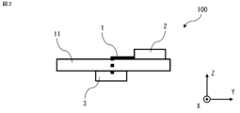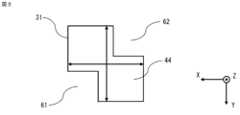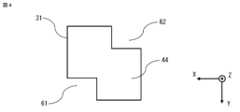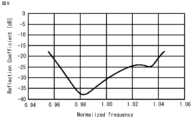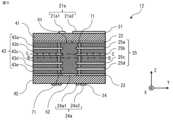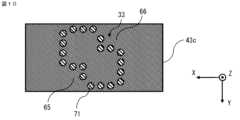JP7699730B2 - Multilayer substrate and antenna device using same - Google Patents
Multilayer substrate and antenna device using sameDownload PDFInfo
- Publication number
- JP7699730B2 JP7699730B2JP2024575990AJP2024575990AJP7699730B2JP 7699730 B2JP7699730 B2JP 7699730B2JP 2024575990 AJP2024575990 AJP 2024575990AJP 2024575990 AJP2024575990 AJP 2024575990AJP 7699730 B2JP7699730 B2JP 7699730B2
- Authority
- JP
- Japan
- Prior art keywords
- conductor layer
- waveguide
- layer
- dielectric layer
- intermediate dielectric
- Prior art date
- Legal status (The legal status is an assumption and is not a legal conclusion. Google has not performed a legal analysis and makes no representation as to the accuracy of the status listed.)
- Active
Links
Images
Classifications
- H—ELECTRICITY
- H01—ELECTRIC ELEMENTS
- H01P—WAVEGUIDES; RESONATORS, LINES, OR OTHER DEVICES OF THE WAVEGUIDE TYPE
- H01P1/00—Auxiliary devices
- H01P1/02—Bends; Corners; Twists
- H—ELECTRICITY
- H01—ELECTRIC ELEMENTS
- H01P—WAVEGUIDES; RESONATORS, LINES, OR OTHER DEVICES OF THE WAVEGUIDE TYPE
- H01P5/00—Coupling devices of the waveguide type
- H01P5/08—Coupling devices of the waveguide type for linking dissimilar lines or devices
Landscapes
- Waveguides (AREA)
Description
Translated fromJapanese本願は、多層基板及びそれを用いたアンテナ装置に関するものである。The present application relates to a multilayer substrate and an antenna device using the same.
アンテナ装置は、マイクロ波帯あるいはミリ波帯の高周波信号を伝送する装置である。アンテナ装置は、アンテナと、高周波信号を発生させる高周波信号発生器であるIC(Integrated Circuit)と、給電線路とを備える。給電線路は、アンテナとICとを接続する。ICは、アンテナ及び給電線路が形成された誘電体基板の基板面と異なる基板面に実装される場合がある。The antenna device is a device that transmits high-frequency signals in the microwave or millimeter wave band. The antenna device includes an antenna, an integrated circuit (IC) that is a high-frequency signal generator that generates a high-frequency signal, and a feed line. The feed line connects the antenna and the IC. The IC may be mounted on a substrate surface different from the substrate surface of the dielectric substrate on which the antenna and the feed line are formed.
ICをアンテナが形成された誘電体基板の基板面と異なる面に実装する場合、双方の面を接続するための回路(変換器)が必要である。誘電体基板である多層基板の内層に、誘電体を充填した導波管を形成した構成が開示されている(例えば、特許文献1参照)。特
許文献1では、変換器は、多層基板と、多層基板の内層に形成され、誘電体を充填した導
波管と、マイクロストリップ線路とを有し、導波管からマイクロストリップ線路へ信号は伝搬する。開示された変換器を用いれば、多層基板の表面と裏面とを接続することができる。 When mounting an IC on a surface of a dielectric substrate different from the substrate surface on which the antenna is formed, a circuit (converter) is required to connect the two surfaces. A configuration is disclosed in which a waveguide filled with a dielectric is formed in an inner layer of a multilayer substrate, which is a dielectric substrate (see, for example, Patent Document 1). In
多層基板の内層に形成され、誘電体を充填した導波管を用いることで、多層基板の表面と裏面とを接続することができる。しかしながら、開示された導波管の形状により多層基板の表面と裏面とを接続する場合、伝搬させる信号の方向は、一つの特定の方向に限られている。例えば、表面に設けられ、一つの特定の方向であるX方向に延出したマイクロストリップ線路を伝搬した信号は、導波管を介して、裏面に設けられ、X方向に延出したマイクロストリップ線路のみを伝搬することになる。そのため、信号の伝搬方向を表面と裏面とで90度、つまり垂直方向に転換させたい場合、表面、又は裏面のどちらか一方の面に信号の伝搬方向を変えるための追加の給電線路が必要となる。The front and back surfaces of the multilayer board can be connected by using a waveguide filled with a dielectric material formed in an inner layer of the multilayer board. However, when the front and back surfaces of the multilayer board are connected by the disclosed shape of the waveguide, the direction of the signal to be propagated is limited to one specific direction. For example, a signal propagated through a microstrip line provided on the front surface and extending in one specific direction, the X-direction, propagates only through a microstrip line provided on the back surface and extending in the X-direction via the waveguide. Therefore, when it is desired to change the signal propagation direction between the front surface and the back surface by 90 degrees, i.e., to the vertical direction, an additional feeder line is required on either the front surface or the back surface to change the signal propagation direction.
追加の給電線路において、例えば、給電線路を引き回せるスペースの確保が十分できない場合、信号の伝搬方向を急激に変えなければならない。信号の伝搬方向を急激に変えた給電線路では、不連続部が発生することになる。不連続部では、不要な電波が放射(以下、不要放射と称する)される。不要放射は、その量によって、アンテナ性能及び回路性能に影響を与える。そのため、不連続部から不要放射が発生するという課題があった。不要放射の量を抑制するためには、追加の給電線路において緩慢に線路の方向を転換すればよい。しかしながら、追加の給電線路の方向を緩慢に転換した場合、給電線路を引き回すスペースが増大するので、給電線路を設けた回路の面積が増大し、多層基板が大型化するという課題があった。また、回路の面積が増大するため、多層基板の設計の自由度が低減するという課題があった。In the additional power feed line, for example, when there is not enough space to route the power feed line, the signal propagation direction must be changed abruptly. In the power feed line where the signal propagation direction is changed abruptly, a discontinuous portion occurs. In the discontinuous portion, unnecessary radio waves are radiated (hereinafter referred to as unnecessary radiation). The amount of unnecessary radiation affects the antenna performance and the circuit performance. Therefore, there is a problem that unnecessary radiation occurs from the discontinuous portion. In order to suppress the amount of unnecessary radiation, the direction of the additional power feed line may be changed gradually. However, when the direction of the additional power feed line is changed gradually, the space for routing the power feed line increases, so that the area of the circuit in which the power feed line is provided increases, and the multilayer board becomes larger. In addition, there is a problem that the degree of freedom in designing the multilayer board is reduced because the area of the circuit increases.
そこで、本願は、不要放射の量を抑制すると共に、小型化及び設計自由度が向上した多層基板、及びそれを用いたアンテナ装置を得ることを目的とする。Therefore, an object of the present application is to provide a multilayer board that suppresses the amount of unnecessary radiation, while also being miniaturized and improving design freedom, and an antenna device using the same.
本願に開示される多層基板は、一方の側に第一導体層、及び前記一方の側とは反対側の他方の側に第二導体層を有した第一の誘電体層と、一方の側に第三導体層、及び前記一方の側とは反対側の他方の側に第四導体層を有し、前記第二導体層と間隔を空けて前記第三導体層が配置された第二の誘電体層と、前記第二導体層と前記第三導体層との間に配置された単数又は複数の中間誘電体層と、前記第二導体層から前記第三導体層の方向に前記中間誘電体層の特定の部分を貫通した貫通孔の内周面に当接した導電性の筒状部材であって、前記筒状部材の内側に前記第一の誘電体層、前記第二の誘電体層、及び前記中間誘電体層とは異なる材料からなる誘電体が充填された導波管とを備え、複数の前記中間誘電体層を有した場合、複数の前記中間誘電体層のそれぞれの間の部分には、中間導体層が設けられ、前記導波管における前記中間誘電体層を貫通した方向に対して垂直な断面の形状は、四角形の1つの対角線上の角部の双方が切り欠かれた形状である。The multilayer substrate disclosed in the present application comprises: a first dielectric layer having a first conductor layer on one side and a second conductor layer on the other side opposite to the one side; a second dielectric layer having a third conductor layer on one side and a fourth conductor layer on the other side opposite to the one side, the third conductor layer being disposed at a distance from the second conductor layer; one or more intermediate dielectric layers disposed between the second conductor layer and the third conductor layer; and a conductive tubular member abutting against an inner circumferential surface of a through hole penetrating a specific portion of the intermediate dielectric layer in a direction from the second conductor layer to the third conductor layer, the inside of the tubular member being filled with a dielectric made of a material different from the first dielectric layer, the second dielectric layer, and the intermediate dielectric layer. When the substrate has a plurality of intermediate dielectric layers, an intermediate conductor layer is provided in a portion between each of the plurality of intermediate dielectric layers, and the shape of a cross section of the waveguide perpendicular to the direction of penetrating the intermediate dielectric layer is a rectangle in which both corners on one diagonal are cut out.
本願に開示されるアンテナ装置は、本願に開示された多層基板と、前記第一導体層又は前記第四導体層に形成されたアンテナと、を備えたものである。The antenna device disclosed in the present application includes the multilayer substrate disclosed in the present application and an antenna formed on the first conductor layer or the fourth conductor layer.
本願に開示される多層基板によれば、一方の側に第一導体層、及び一方の側とは反対側の他方の側に第二導体層を有した第一の誘電体層と、一方の側に第三導体層、及び一方の側とは反対側の他方の側に第四導体層を有し、第二導体層と間隔を空けて第三導体層が配置された第二の誘電体層と、第二導体層と第三導体層との間に配置された単数又は複数の中間誘電体層と、中間誘電体層の特定の部分を貫通した貫通孔の内周面に当接した導電性の筒状部材であって、筒状部材の内側に第一の誘電体層、第二の誘電体層、及び中間誘電体層とは異なる材料からなる誘電体が充填された導波管とを備え、導波管における中間誘電体層を貫通した方向に対して垂直な断面の形状が、四角形の1つの対角線上の角部の双方が切り欠かれた形状であるため、多層基板の内側において信号の伝搬する方向を90度変えることができるので、第一導体層又は第四導体層のどちらか一方の層において信号の伝搬方向を変えるための追加の導体パターンが不要になる。追加の導体パターンが不要になるので、多層基板を小型化することができる。また、追加の導体パターンが不要になり回路の面積が増大しないので、多層基板の設計自由度を向上させることができる。また、信号の伝搬方向を急激に変える不連続部が発生しないので、多層基板における不要放射の量を抑制することができる。The multilayer board disclosed in the present application comprises a first dielectric layer having a first conductor layer on one side and a second conductor layer on the other side opposite to the first side, a second dielectric layer having a third conductor layer on one side and a fourth conductor layer on the other side opposite to the first side, the third conductor layer being disposed at a distance from the second conductor layer, one or more intermediate dielectric layers being disposed between the second conductor layer and the third conductor layer, and a waveguide which is a conductive tubular member abutting on an inner circumferential surface of a through hole penetrating a specific portion of the intermediate dielectric layer, the inside of the tubular member being filled with a dielectric made of a material different from the first dielectric layer, the second dielectric layer, and the intermediate dielectric layer, and the shape of a cross section of the waveguide perpendicular to the direction of penetrating the intermediate dielectric layer is a rectangle with both corners on one diagonal line cut out, so that the propagation direction of a signal can be changed by 90 degrees inside the multilayer board, and therefore an additional conductor pattern for changing the propagation direction of a signal is not required in either the first conductor layer or the fourth conductor layer. Since no additional conductor patterns are required, the multilayer board can be made smaller. Also, since no additional conductor patterns are required and the circuit area does not increase, the design freedom of the multilayer board can be improved. Also, since no discontinuities that suddenly change the signal propagation direction occur, the amount of unwanted radiation in the multilayer board can be suppressed.
本願に開示されるアンテナ装置によれば、本願に開示された多層基板と、第一導体層又は第四導体層に接続されたアンテナと、を備えたため、本願に開示した多層基板をアンテナ装置に用いることで、不要放射の量を抑制すると共に、小型化及び設計自由度が向上したアンテナ装置を得ることができる。According to the antenna device disclosed in the present application, the antenna device comprises the multilayer substrate disclosed in the present application and an antenna connected to the first conductor layer or the fourth conductor layer. Therefore, by using the multilayer substrate disclosed in the present application in an antenna device, it is possible to obtain an antenna device that is smaller in size and has improved design freedom while suppressing the amount of unwanted radiation.
以下、本願の実施の形態による多層基板及びそれを用いたアンテナ装置を図に基づいて説明する。なお、各図において同一、または相当部材、部位については同一符号を付して説明する。Hereinafter, a multilayer substrate and an antenna device using the same according to an embodiment of the present invention will be described with reference to the drawings. Note that the same or corresponding members and parts are denoted by the same reference numerals in each drawing.
実施の形態1.
図1は実施の形態1に係る多層基板11の概略を示す断面図で、図6のA-A断面位置で多層基板11を切断した図、図2は実施の形態1に係る多層基板11を用いたアンテナ装置100の概略を示す模式図、図3は多層基板11の導波管31の概略を示す断面図で、導波管31の貫通した方向に対して垂直な断面の形状を示した図、図4は多層基板11の別の導波管31の概略を示す断面図で、導波管31の貫通した方向に対して垂直な断面の形状を示した図、図5は多層基板11の別の導波管32の概略を示す断面図で、導波管32の貫通した方向に対して垂直な断面の形状を示した図、図6は多層基板11の概略を示す分解斜視図、図7は多層基板11の導波管31の動作を説明する図、図8は多層基板11の導波管31における伝送線路特性を示す図で、反射係数の電磁界解析の結果を示した図である。なお、図中に記載するX軸、Y軸及びZ軸は、互いに垂直な3軸とする。Y軸に平行な方向を第1の方向であるY軸方向、X軸に平行な方向を第2の方向であるX軸方向、Z軸に平行な方向を第3の方向であるZ軸方向とする。X軸方向のうち図中矢印で示す方向をプラスX方向、プラスX方向の逆の方向をマイナスX方向とし、Y軸方向及びZ軸方向についてもX軸方向の場合と同様とする。
FIG. 1 is a cross-sectional view showing an outline of a
<アンテナ装置100>
アンテナ装置100は、図2に示すように、多層基板11と、高周波信号発生器2と、アンテナ3とを備える。多層基板11は、高周波信号発生器2からアンテナ3に信号を伝搬する給電線路1を備える。給電線路1を用いたアンテナ装置100は、マイクロ波帯あるいはミリ波帯の高周波信号を伝送する装置である。マイクロ波は波長が1mmから1m、周波数が300MHzから300GHzである。ミリ波は波長が1mmから10mm、周波数が30GHzから300GHzである。アンテナ装置100は、信号を第1の方向から第2の方向に伝搬させる。<
As shown in Fig. 2, the
高周波信号を発生させる高周波信号発生器2は、例えば、IC(Integrated
Circuit)で設けられる。給電線路1は、高周波信号発生器2とアンテナ3とを接続する。多層基板11に高周波信号発生器2が配置されると共に、多層基板11にアンテナ3が接続される。高周波信号発生器2は、アンテナ3が接続された多層基板11の基板面と異なる面に実装される。アンテナ3は、後述する第一導体層又は第四導体層に接続される。第一導体層は、例えば、多層基板11の一方の基板面に設けられ、第四導体層は多層基板11の他方の基板面に設けられる。アンテナ3が第一導体層に接続された場合、高周波信号発生器2は第四導体層の側に配置され、アンテナ3が第四導体層に接続された場合、高周波信号発生器2は第一導体層の側に配置される。 The high
The
<多層基板11>
多層基板11は、図1に示すように、一方の側に第一導体層21、及び一方の側とは反対側の他方の側に第二導体層22を有した第一の誘電体層41と、一方の側に第三導体層23、及び一方の側とは反対側の他方の側に第四導体層24を有し、第二導体層22と間隔を空けて第三導体層23が配置された第二の誘電体層42と、第二導体層22と第三導体層23との間に配置された単数又は複数の中間誘電体層43と、導波管31とを備える。中間誘電体層43は、単数でも複数でも構わない。本実施の形態では、多層基板11は、5つの中間誘電体層43として、中間誘電体層43a、43b、43c、43d、43eを有する。多層基板11が複数の中間誘電体層43を有した場合、複数の中間誘電体層43のそれぞれの間の部分には、中間導体層25が設けられる。本実施の形態では、多層基板11が5つの中間誘電体層43を有するため、4つの中間導体層25a、25b、25c、25dが設けられる。多層基板11が有した導体層のそれぞれは、例えば、銅箔である。図1では、第一の誘電体層41、第二の誘電体層42、及び中間誘電体層43はZ方向に積層され、板状のそれぞれの層が積層される面は、X方向及びY方向に平行である。<
As shown in Fig. 1, the
導波管31は、第二導体層22から第三導体層23の方向に中間誘電体層43の特定の部分を貫通した貫通孔の内周面に当接した導電性の筒状部材であって、筒状部材の内側に第一の誘電体層41、第二の誘電体層42、及び中間誘電体層43とは異なる材料からなる誘電体44が充填されている。第一の誘電体層41、第二の誘電体層42、及び中間誘電体層43の材料は、例えば、ガラス布基材エポキシ樹脂である。導波管31に充填された誘電体44の材料は、例えば、エポキシ樹脂である。導波管31の内側の誘電体44と誘電体層とで異なる誘電体にすることで、導波管31の内側に低損失な誘電体44を設けることができる。導波管31の内側に低損失な誘電体44を設けることで、導波管31の性能を向上させることができる。The
第一導体層21には、図6に示すように、第一導体パターン21aが形成される。第四導体層24には、第四導体パターン24aが形成される。図6では、第四導体パターン24aは外形のみを破線で示す。本実施の形態では、給電線路1は、第一導体パターン21aと、第四導体パターン24aと、導波管31とから形成される。本実施の形態における第一導体パターン21aの形状について説明する。第一導体パターン21aは、矩形の開口部を有した環状線路部21a1と、環状線路部21a1からプラスY方向に延出した入出力端子部21a2とを有する。開口部の形状は矩形に限るものではなく、例えば、矩形以外の多角形であっても構わない。入出力端子部21a2は、環状線路部21a1と第一の誘電体層41の端部との間の部分で幅の変わる多段形状を有している。第一導体パターン21aは、X方向の両側であって、環状線路部21a1に隣接した位置に、環状線路部21a1とは隙間を空けて配置された非接続部21a3を有する。本実施の形態では、非接続部21a3の形状は矩形であるが、非接続部21a3の形状は矩形に限るものではなく、例えば、矩形以外の多角形であっても構わない。As shown in FIG. 6, the
第四導体パターン24aの形状は、第一導体パターン21aの形状と同様である。第四導体パターン24aは、環状線路部24a1と、入出力端子部24a2と、非接続部24a3とを有する。ただし、入出力端子部24a2の延出方向が入出力端子部21a2の延出方向とは異なっており、入出力端子部24a2の延出方向は、マイナスX方向である。アンテナ3は、入出力端子部21a2又は入出力端子部24a2の端部に接続される。The shape of the
第一導体パターン21aは、第二スロット51と電磁界結合する。環状線路部21a1の開口部は、Z方向に見て、図1に示すように、第二スロット51と重複して配置されている。第四導体パターン24aは、第三スロット52と電磁界結合する。環状線路部24a1の開口部は、Z方向に見て、第三スロット52と重複して配置されている。それぞれの導体パターンがそれぞれのスロットと電磁界結合する形状であれば、導体パターンの形状は、本実施の形態に示した形状に限るものではない。The
第二導体層22には、図6に示すように、第二導体層22の開口した部分である第二スロット51が形成される。第三導体層23には、第三導体層23の開口した部分である第三スロット52が形成される。第二スロット51は、第一導体パターン21a及び導波管31と電磁界結合する。第二スロット51は、Z方向に見て、図1に示すように、第一導体パターン21a及び導波管31の内側部分と重複して配置されている。第三スロット52は、第四導体パターン24a及び導波管31と電磁界結合する。第三スロット52は、Z方向に見て、第四導体パターン24a及び導波管31の内側部分と重複して配置されている。As shown in Fig. 6, the
本実施の形態では、第二スロット51及び第三スロット52は、長方形に形成される。それぞれのスロットがそれぞれの導体パターン及び導波管31と電磁界結合する形状であれば、スロットの形状は、本実施の形態に示した形状に限るものではない。スロットは、形状が正方形又は矩形以外の多角形、又はスロットの内側の領域に浮遊導体パターンを有した構成であっても構わない。In this embodiment, the
<導波管31>
本願の要部である導波管31の構成について説明する。導波管31における中間誘電体層43を貫通した方向に対して垂直な断面の形状は、四角形の1つの対角線上の角部の双方が切り欠かれた形状である。切り欠かれた部分を、切欠き部61、62と称する。図3に示した導波管31における中間誘電体層43を貫通した方向に対して垂直な断面の切り欠かれた部分の形状は、四角形である。切欠き部61、62の形状は、正方形でもよく、図4に示すように、長方形であっても構わない。導波管31の断面の四角形が正方形であり、切欠き部61、62が正方形の場合、切り欠きを設けた対角線とは反対側の対角線に対して切欠き部61、62は対称に配置される。導波管31の断面の四角形が正方形であり、切欠き部61、62が長方形の場合、切り欠きを設けた対角線とは反対側の対角線に対して切欠き部61、62は非対称に配置される。<
The configuration of the
切欠き部の形状を四角形とした場合、切り欠きの形状が単純な形状であるため、導波管31を伝搬する伝送線路特性の整合条件に応じて、導波管31の形状の設計を容易に行うことができる。切欠き部の形状は四角形に限るものではなく、伝送線路特性の整合条件に応じて、例えば、四角形以外の多角形、又は左右が非対称な切り欠き形状でも構わない。切欠き部の形状を四角形以外にした場合、設計のパラメータが増えるため、より精密な伝送特性を備えた導波管31を設計することができる。When the shape of the cutout is a rectangle, the shape of the cutout is simple, and therefore the shape of the
導波管31の断面の四角形における角部は、直角である、又は丸みを帯びた形状である。本実施の形態の図3に示した導波管31の断面の四角形における角部は、直角である。角部が直角である場合、導波管31において、所望の伝送特性を容易に得ることができる。導波管31の断面の四角形における角部は、直角に限るものではない。図5に示した別の導波管32の例のように、導波管31の断面の四角形における角部は、例えば、導波管32の製造条件、又は伝送線路特性の整合条件に応じて、丸みを帯びた形状であっても構わない。別の導波管32は、切欠き部63、64を有する。角部が丸みを帯びた形状である場合、導波管32の製造性が向上するため、多層基板11の生産性を向上させることができる。The corners of the rectangular cross section of the
切欠き部61、62を設けた導波管31の動作について、図7(a)から図7(c)を用いて説明する。図7(a)から図7(c)に示した矢印は、第二スロット51、導波管31、第三スロット52のそれぞれに励起される電界方向を示す。ここでは、信号が第一導体パターン21aのマイナスY方向に伝搬した後、導波管31を経由して、第四導体パターン24aのマイナスX方向に伝搬すると仮定して説明する。図において、電界が励起された箇所を実線で示し、その後に電界が励起される箇所を破線で示し、他の箇所を点線で示す。The operation of the
第一導体パターン21aのマイナスY方向に伝搬する信号は、図7(a)に示すように、第二スロット51に電磁結合し、第二スロット51にマイナスY方向(X軸に対して垂直な方向)に電界が励起する。第二スロット51に電磁結合した信号は、図7(b)に示すように、導波管31を伝搬する。導波管31を伝搬する信号は、導波管31の形状に応じて、X軸に対して45度回転して伝搬する。その後、X軸方向に対して45度に回転した信号は、図7(c)に示すように、第三スロット52に電磁結合する。第三スロット52に電磁結合する信号は、第三スロット52の開口形状に応じて、さらにX軸に対して45度回転して伝搬する。第三スロット52を伝搬する信号の電界方向は、第二スロット51を伝搬した信号の電界方向に対して90度回転した状態となり、最終的に、第四導体パターン24aに電磁結合して、マイナスX方向に伝搬する。A signal propagating in the negative Y direction of the
このように導波管31における中間誘電体層43を貫通した方向に対して垂直な断面の形状を、四角形の1つの対角線上の角部の双方が切り欠かれた形状にしたため、多層基板11の内側において信号の伝搬する方向を90度変えることができる。多層基板11の内側において信号の伝搬する方向を90度変えることができるので、第一導体パターン21aを設けた第一導体層21、又は第四導体パターン24aを設けた第四導体層24のどちらか一方の層において信号の伝搬方向を変えるための追加の導体パターンが不要になる。追加の導体パターンが不要になるので、多層基板11を小型化することができる。また、追加の導体パターンが不要になり回路の面積が増大しないので、多層基板11の設計自由度を向上させることができる。また、信号の伝搬方向を急激に変える不連続部が発生しないので、不要放射の量を抑制することができる。また、このような多層基板11をアンテナ装置100に用いることで、不要放射の量を抑制すると共に、小型化及び設計自由度が向上したアンテナ装置100を得ることができる。In this way, the shape of the cross section perpendicular to the direction of penetrating the
上述した導波管31の構造の有効性について、図8を例として説明する。図8は、電磁界解析により求めた規格化周波数に対する反射係数を示した図で、横軸は規格化周波数、縦軸は反射係数である。図において、規格化周波数「1」を中心として、帯域幅8%以上で反射係数が-20dB以下であり、良好な特性が実現されていることがわかる。この特性は、透過周波数で反射がなく伝搬することを意味しており、本願で開示した導波管31の構造により、良好な特性で信号の伝搬方向を90度変えることができる。図8は図3に示した垂直な断面を有する導波管31での解析結果を示すものであるが、導波管31の構造の有効性は実施の形態1に示す他の導波管31の形状、及び後述する他の実施の形態においても同様である。The effectiveness of the structure of the above-mentioned
<導波管31の寸法>
導波管31の寸法について説明する。中間誘電体層43における導波管31の貫通方向の長さは、導波管31を伝搬する信号の波長の4分の1波長の長さである。図1において、導波管31を伝搬する信号の方向は、プラスZ方向、又はマイナスZ方向である。導波管31を伝搬する信号の波長は、導波管31を伝搬する信号の波長の4分の1波長の長さに限るものではなく、好ましい伝送線路特性、又は設計仕様に応じで長さを変更しても構わない。中間誘電体層43における導波管31の貫通方向の長さを、導波管31を伝搬する信号の波長の4分の1波長の長さにした場合、導波管31において、所望の伝送特性を容易に得ることができる。<Dimensions of
The dimensions of the
具体的な導波管31の寸法の例について説明する。導波管31を伝搬する信号の周波数を77GHz、誘電体44の比誘電率を3とした場合、管内波長は2.25mmと計算される。この場合、管内波長の4分の1波長の長さは0.56mmになる。中間誘電体層43における導波管31の貫通方向の長さが0.56mmとなるように、導波管31は多層基板11に設けられる。導波管31の貫通方向の長さを0.56mmとした場合、多層基板11の厚みは、例えば、1.1mmである。A specific example of the dimensions of the
導波管31の断面の四角形における対向した辺の間の距離は、導波管31を伝搬する信号の波長の2分の1波長の長さである。図3において、導波管31の断面の四角形における対向した辺の間の距離は矢印で示した距離である。導波管31の断面の四角形における対向した辺の間の距離は、導波管31を伝搬する信号の波長の2分の1波長の長さに限るものではなく、好ましい伝送線路特性、又は設計仕様に応じで長さを変更しても構わない。導波管31の断面の四角形における対向した辺の間の距離を、導波管31を伝搬する信号の波長の2分の1波長の長さにした場合、導波管31において、所望の伝送特性を容易に得ることができる。The distance between the opposing sides in the rectangular cross section of the
<導波管31の形成>
導波管31の形成方法の例を、図1に示した導波管31について説明する。まず、5つの中間誘電体層43と4つの中間導体層25が設けられた状態で、中間誘電体層43の特定の部分を貫通した貫通孔をドリルにより形成する。次に、貫通孔の内周面にめっきを施し、導電性の筒状部材を形成する。めっきの材料は、例えば、銅である。導電性の筒状部材と中間導体層25とは、電気的に接続されている。次に、筒状部材の内側に第一の誘電体層41、第二の誘電体層42、及び中間誘電体層43とは異なる材料からなる誘電体44を充填する。充填する誘電体44の材料は、例えば、エポキシ樹脂である。このようにして、多層基板11の導波管31の部分は形成される。これらの工程の後、第二導体層22、第三導体層23、第一の誘電体層41、第二の誘電体層42、第一導体層21、及び第四導体層24が積層して設けられる。次に、第一導体層21に第一導体パターン21aを設け、第四導体層24に第四導体パターン24aを設けることで、多層基板11が形成される。<Formation of
An example of a method for forming the
以上のように、実施の形態1による多層基板11は、一方の側に第一導体層21及び他方の側に第二導体層22を有した第一の誘電体層41と、一方の側に第三導体層23及び他方の側に第四導体層24を有し、第二導体層22と間隔を空けて第三導体層23が配置された第二の誘電体層42と、第二導体層22と第三導体層23との間に配置された単数又は複数の中間誘電体層43と、中間誘電体層43の特定の部分を貫通した貫通孔の内周面に当接した導電性の筒状部材であって、筒状部材の内側に第一の誘電体層41、第二の誘電体層42、及び中間誘電体層43とは異なる材料からなる誘電体44が充填された導波管31とを備え、導波管31における中間誘電体層43を貫通した方向に対して垂直な断面の形状が、四角形の1つの対角線上の角部の双方が切り欠かれた形状であるため、多層基板11の内側において信号の伝搬する方向を90度変えることができるので、第一導体層21又は第四導体層24のどちらか一方の層において信号の伝搬方向を変えるための追加の導体パターンが不要になる。追加の導体パターンが不要になるので、多層基板11を小型化することができる。また、追加の導体パターンが不要になり回路の面積が増大しないので、多層基板11の設計自由度を向上させることができる。また、信号の伝搬方向を急激に変える不連続部が発生しないので、多層基板11における不要放射の量を抑制することができる。As described above, the
中間誘電体層43における導波管31の貫通方向の長さが、導波管31を伝搬する信号の波長の4分の1波長の長さである場合、導波管31において、所望の伝送特性を容易に得ることができる。また、導波管31の断面の四角形における対向した辺の間の距離が、導波管31を伝搬する信号の波長の2分の1波長の長さである場合、導波管31において、所望の伝送特性を容易に得ることができる。When the length of the
導波管31の断面の四角形における角部が、直角である場合、導波管31において、所望の伝送特性を容易に得ることができる。導波管31の断面の四角形における角部が、丸みを帯びた形状である場合、所望の伝送特性を容易に得ることができると共に、導波管31の製造性が向上するため、多層基板11の生産性を向上させることができる。When the corners of the rectangular cross section of the
導波管31における中間誘電体層43を貫通した方向に対して垂直な断面の切り欠かれた部分の形状が、四角形である場合、切り欠きの形状が単純な形状であるため、導波管31を伝搬する伝送線路特性の整合条件に応じて、導波管31の形状の設計を容易に行うことができる。また、切欠き部61、62の形状を四角形以外にした場合、設計のパラメータが増えるため、より精密な伝送特性を備えた導波管31を設計することができる。When the shape of the notched portion of the
実施の形態1によるアンテナ装置100が、本願に開示した多層基板11と、第一導体層21又は第四導体層24に接続されたアンテナ3とを備えた場合、本願に開示した多層基板11をアンテナ装置100に用いることで、不要放射の量を抑制すると共に、小型化及び設計自由度が向上したアンテナ装置100を得ることができる。When the
実施の形態2.
実施の形態2に係る多層基板12について説明する。図9は実施の形態2に係る多層基板12の概略を示す断面図で、図6のA-A断面位置と同等の位置で多層基板12を切断した図、図10は図9のB-B断面位置で切断した多層基板12の断面図で、中間誘電体層43cの部分の断面図、図11は図9のC-C断面位置で切断した多層基板12の断面図で、中間導体層25bの部分の断面図である。実施の形態2に係る多層基板12は、複数のビアホール71により導波管33が形成された構成になっている。
A
多層基板11は、図9に示すように、一方の側に第一導体層21、及び一方の側とは反対側の他方の側に第二導体層22を有した第一の誘電体層41と、一方の側に第三導体層23、及び一方の側とは反対側の他方の側に第四導体層24を有し、第二導体層22と間隔を空けて第三導体層23が配置された第二の誘電体層42と、第二導体層22と第三導体層23との間に配置された単数又は複数の中間誘電体層43と、第二導体層22から第三導体層23の方向に中間誘電体層43を貫通し、中間誘電体層43の特定の部分を取り囲む複数のビアホール71とを備える。中間誘電体層43は、単数でも複数でも構わない。本実施の形態では、多層基板11は、5つの中間誘電体層43として、中間誘電体層43a、43b、43c、43d、43eを有する。多層基板11が複数の中間誘電体層43を有した場合、少なくとも、複数のビアホール71からなる導波管33及び特定の部分を除いた複数の中間誘電体層43のそれぞれの間の部分には、中間導体層25が設けられる。本実施の形態では、多層基板11が5つの中間誘電体層43を有するため、4つの中間導体層25a、25b、25c、25dが設けられる。多層基板11が有した導体層のそれぞれは、例えば、銅箔である。As shown in Fig. 9, the
図10に示すように、複数のビアホール71により導波管33が形成される。導波管33における中間誘電体層43を貫通した方向に対して垂直な断面における複数のビアホール71をつなげた線の形状は、四角形の1つの対角線上の角部の双方が切り欠かれた形状である。切り欠かれた部分を、切欠き部65、66と称する。図11に示すように、中間導体層25bは、中間誘電体層43の特定の部分を取り囲む開口部25b1を有する。図11に示された中間誘電体層43の部分は、中間誘電体層43cの部分である。中間導体層25a、25c、25dも、中間導体層25bと同様の構成である。複数のビアホール71は、中間誘電体層43の特定の部分を取り囲む開口部25b1の周囲の部分に重なるように設けられる。複数のビアホール71と中間導体層25とは、電気的に接続されている。図10では20個のビアホール71により導波管33が形成される構成であるが、ビアホール71の個数はこれに限るものではない。As shown in FIG. 10, the
複数のビアホール71により形成された導波管33は、垂直な断面における複数のビアホール71をつなげた線の形状は、四角形の1つの対角線上の角部の双方が切り欠かれた形状であるため、実施の形態1の導波管31と同様に、多層基板12の内側において信号の伝搬する方向を90度変えることができる。多層基板11の内側において信号の伝搬する方向を90度変えることができるので、第一導体パターン21aを設けた第一導体層21、又は第四導体パターン24aを設けた第四導体層24のどちらか一方の層において信号の伝搬方向を変えるための追加の導体パターンが不要になる。追加の導体パターンが不要になるので、多層基板12を小型化することができる。また、追加の導体パターンが不要になり回路の面積が増大しないので、多層基板12の設計自由度を向上させることができる。また、信号の伝搬方向を急激に変える不連続部が発生しないので、不要放射の量を抑制することができる。In the
実施の形態1に示した導波管31は、中間誘電体層43の特定の部分を貫通した貫通孔をドリルで形成していた。そのため、導波管31の形状は、特に導波管31の角部のような隅の部分において、貫通孔を形成するドリルのサイズに依存していた。本実施の形態では、複数のビアホール71により導波管33を形成しているため、導波管33の形状はドリルのサイズに依存しないので、導波管33の形状に対する設計自由度を向上させることができる。In the
以上のように、実施の形態2による多層基板12は、第二導体層22から第三導体層23の方向に中間誘電体層43を貫通し、中間誘電体層43の特定の部分を取り囲む複数のビアホール71を備え、複数のビアホール71により導波管33が形成され、導波管33における中間誘電体層43を貫通した方向に対して垂直な断面における複数のビアホール71をつなげた線の形状は、四角形の1つの対角線上の角部の双方が切り欠かれた形状であるため、多層基板11の内側において信号の伝搬する方向を90度変えることができるので、第一導体層21又は第四導体層24のどちらか一方の層において信号の伝搬方向を変えるための追加の導体パターンが不要になる。また、複数のビアホール71により導波管33を形成しているため、導波管33の形状に対する設計自由度を向上させることができる。また、信号の伝搬方向を急激に変える不連続部が発生しないので、不要放射の量を抑制することができる。As described above, the
また本願は、様々な例示的な実施の形態及び実施例が記載されているが、1つ、または複数の実施の形態に記載された様々な特徴、態様、及び機能は特定の実施の形態の適用に限られるのではなく、単独で、または様々な組み合わせで実施の形態に適用可能である。
従って、例示されていない無数の変形例が、本願明細書に開示される技術の範囲内において想定される。例えば、少なくとも1つの構成要素を変形する場合、追加する場合または省略する場合、さらには、少なくとも1つの構成要素を抽出し、他の実施の形態の構成要素と組み合わせる場合が含まれるものとする。 Although the present application describes various exemplary embodiments and examples, the various features, aspects, and functions described in one or more embodiments are not limited to application to a particular embodiment, but may be applied to the embodiments alone or in various combinations.
Therefore, countless modifications not exemplified are assumed within the scope of the technology disclosed in the present specification, including, for example, modifying, adding, or omitting at least one component, and further, extracting at least one component and combining it with a component of another embodiment.
1 給電線路、2 高周波信号発生器、3 アンテナ、11、12 多層基板、21 第一導体層、21a 第一導体パターン、21a1 環状線路部、21a2 入出力端子部、21a3 非接続部、22 第二導体層、23 第三導体層、24 第四導体層、24a 第四導体パターン、24a1 環状線路部、24a2 入出力端子部、24a3 非接続部、25、25a、25b、25c、25d 中間導体層、25b1 開口部、31、32、33 導波管、41 第一の誘電体層、42 第二の誘電体層、43、43a、43b、43c、43d、43e 中間誘電体層、44 誘電体、51 第二スロット、52 第三スロット、61、62、63、64、65、66 切欠き部、71 ビアホール、100 アンテナ装置REFERENCE SIGNS LIST 1: power supply line, 2: high frequency signal generator, 3: antenna, 11, 12: multilayer substrate, 21: first conductor layer, 21a: first conductor pattern, 21a1: annular line portion, 21a2: input/output terminal portion, 21a3: non-connecting portion, 22: second conductor layer, 23: third conductor layer, 24: fourth conductor layer, 24a: fourth conductor pattern, 24a1: annular line portion, 24a2: input/output terminal portion, 24a3: non-connecting portion, 25, 25a, 25b, 25c, 25d: intermediate conductor layer, 25b1: opening, 31, 32, 33: waveguide, 41: first dielectric layer, 42: second dielectric layer, 43, 43a, 43b, 43c, 43d, 43e: intermediate dielectric layer, 44: dielectric, 51: second slot, 52 Third slot, 61, 62, 63, 64, 65, 66, notch portion, 71, via hole, 100, antenna device
Claims (7)
Translated fromJapanese一方の側に第三導体層、及び前記一方の側とは反対側の他方の側に第四導体層を有し、前記第二導体層と間隔を空けて前記第三導体層が配置された第二の誘電体層と、
前記第二導体層と前記第三導体層との間に配置された単数又は複数の中間誘電体層と、
前記第二導体層から前記第三導体層の方向に前記中間誘電体層の特定の部分を貫通した貫通孔の内周面に当接した導電性の筒状部材であって、前記筒状部材の内側に前記第一の誘電体層、前記第二の誘電体層、及び前記中間誘電体層とは異なる材料からなる誘電体が充填された導波管と、を備え、
複数の前記中間誘電体層を有した場合、複数の前記中間誘電体層のそれぞれの間の部分には、中間導体層が設けられ、
前記導波管における前記中間誘電体層を貫通した方向に対して垂直な断面の形状は、四角形の1つの対角線上の角部の双方が切り欠かれた形状である多層基板。 a first dielectric layer having a first conductor layer on one side and a second conductor layer on another side opposite the first side;
a second dielectric layer having a third conductor layer on one side and a fourth conductor layer on the other side opposite to the one side, the third conductor layer being disposed at a distance from the second conductor layer;
one or more intermediate dielectric layers disposed between the second conductor layer and the third conductor layer;
a conductive cylindrical member in contact with an inner circumferential surface of a through hole penetrating a specific portion of the intermediate dielectric layer in a direction from the second conductor layer to the third conductor layer, the waveguide being filled with a dielectric material made of a material different from the first dielectric layer, the second dielectric layer, and the intermediate dielectric layer on the inside of the cylindrical member;
When a plurality of the intermediate dielectric layers are provided, an intermediate conductor layer is provided between each of the plurality of intermediate dielectric layers.
A multilayer substrate, wherein the cross section of the waveguide perpendicular to the direction passing through the intermediate dielectric layer has a rectangular shape in which both corners on one diagonal line are cut away.
一方の側に第三導体層、及び前記一方の側とは反対側の他方の側に第四導体層を有し、前記第二導体層と間隔を空けて前記第三導体層が配置された第二の誘電体層と、
前記第二導体層と前記第三導体層との間に配置された単数又は複数の中間誘電体層と、
前記第二導体層から前記第三導体層の方向に前記中間誘電体層を貫通し、前記中間誘電体層の特定の部分を取り囲む複数のビアホールと、を備え、
複数の前記ビアホールにより導波管が形成され、
複数の前記中間誘電体層を有した場合、少なくとも、前記導波管及び前記特定の部分を除いた複数の前記中間誘電体層のそれぞれの間の部分には、中間導体層が設けられ、
前記導波管における前記中間誘電体層を貫通した方向に対して垂直な断面における複数の前記ビアホールをつなげた線の形状は、四角形の1つの対角線上の角部の双方が切り欠かれた形状である多層基板。 a first dielectric layer having a first conductor layer on one side and a second conductor layer on another side opposite the first side;
a second dielectric layer having a third conductor layer on one side and a fourth conductor layer on the other side opposite to the one side, the third conductor layer being disposed at a distance from the second conductor layer;
one or more intermediate dielectric layers disposed between the second conductor layer and the third conductor layer;
a plurality of via holes extending through the intermediate dielectric layer from the second conductor layer toward the third conductor layer and surrounding a particular portion of the intermediate dielectric layer;
A waveguide is formed by the via holes,
When a plurality of the intermediate dielectric layers are provided, an intermediate conductor layer is provided at least in a portion between each of the plurality of intermediate dielectric layers excluding the waveguide and the specific portion,
A multilayer substrate, in which the shape of a line connecting the multiple via holes in a cross section perpendicular to the direction of penetration of the intermediate dielectric layer in the waveguide is a rectangle with both corners on one diagonal line cut out.
前記第一導体層又は前記第四導体層に接続されたアンテナと、を備えたアンテナ装置。 A multilayer substrate according to claim 1or 2 ,
and an antenna connected to the first conductor layer or the fourth conductor layer.
Applications Claiming Priority (1)
| Application Number | Priority Date | Filing Date | Title |
|---|---|---|---|
| PCT/JP2023/004374WO2024166296A1 (en) | 2023-02-09 | 2023-02-09 | Multilayer substrate and antenna device using same |
Publications (3)
| Publication Number | Publication Date |
|---|---|
| JPWO2024166296A1 JPWO2024166296A1 (en) | 2024-08-15 |
| JP7699730B2true JP7699730B2 (en) | 2025-06-27 |
| JPWO2024166296A5 JPWO2024166296A5 (en) | 2025-07-08 |
Family
ID=92262171
Family Applications (1)
| Application Number | Title | Priority Date | Filing Date |
|---|---|---|---|
| JP2024575990AActiveJP7699730B2 (en) | 2023-02-09 | 2023-02-09 | Multilayer substrate and antenna device using same |
Country Status (2)
| Country | Link |
|---|---|
| JP (1) | JP7699730B2 (en) |
| WO (1) | WO2024166296A1 (en) |
Citations (4)
| Publication number | Priority date | Publication date | Assignee | Title |
|---|---|---|---|---|
| WO2005034278A1 (en) | 2003-10-06 | 2005-04-14 | Murata Manufacturing Co., Ltd. | Twist waveguide and radio device |
| JP2011211170A (en) | 2010-03-09 | 2011-10-20 | Hitachi Chem Co Ltd | Electromagnetic coupling structure, multi-layer transmission-line plate, method of manufacturing electromagnetic coupling structure, and method of manufacturing multi-layer transmission-line plate |
| JP2019201197A (en) | 2018-05-11 | 2019-11-21 | 株式会社Soken | Interlayer transmission line |
| WO2022024318A1 (en) | 2020-07-30 | 2022-02-03 | 三菱電機株式会社 | Waveguide coupler |
Family Cites Families (3)
| Publication number | Priority date | Publication date | Assignee | Title |
|---|---|---|---|---|
| WO2010106198A1 (en)* | 2009-03-18 | 2010-09-23 | Radiacion Y Microondas, S.A. | Polarisation rotator with multiple bowtie-shaped sections |
| JP2017005639A (en)* | 2015-06-16 | 2017-01-05 | 日本電気株式会社 | Waveguide fitting device |
| JP2020202248A (en)* | 2019-06-07 | 2020-12-17 | イビデン株式会社 | Wiring board and method of manufacturing wiring board |
- 2023
- 2023-02-09WOPCT/JP2023/004374patent/WO2024166296A1/enactivePending
- 2023-02-09JPJP2024575990Apatent/JP7699730B2/enactiveActive
Patent Citations (4)
| Publication number | Priority date | Publication date | Assignee | Title |
|---|---|---|---|---|
| WO2005034278A1 (en) | 2003-10-06 | 2005-04-14 | Murata Manufacturing Co., Ltd. | Twist waveguide and radio device |
| JP2011211170A (en) | 2010-03-09 | 2011-10-20 | Hitachi Chem Co Ltd | Electromagnetic coupling structure, multi-layer transmission-line plate, method of manufacturing electromagnetic coupling structure, and method of manufacturing multi-layer transmission-line plate |
| JP2019201197A (en) | 2018-05-11 | 2019-11-21 | 株式会社Soken | Interlayer transmission line |
| WO2022024318A1 (en) | 2020-07-30 | 2022-02-03 | 三菱電機株式会社 | Waveguide coupler |
Also Published As
| Publication number | Publication date |
|---|---|
| JPWO2024166296A1 (en) | 2024-08-15 |
| WO2024166296A1 (en) | 2024-08-15 |
Similar Documents
| Publication | Publication Date | Title |
|---|---|---|
| US7154441B2 (en) | Device for transmitting or emitting high-frequency waves | |
| KR20210088527A (en) | High frequency filter and phased array antenna comprising such high frequency filter | |
| JP5566169B2 (en) | Antenna device | |
| JP2004153367A (en) | High frequency module, and mode converting structure and method | |
| JP2005045815A (en) | Millimeter-wave signal conversion device | |
| US9629282B2 (en) | Electronic device, structure, and heat sink | |
| CN115777161A (en) | Multilayer waveguide with a supersurface, arrangement and production method thereof | |
| KR20150125262A (en) | Multi layer board and manufacturing method of it | |
| CN114464975A (en) | Surface mount waveguide for vertical transition of printed circuit boards | |
| JP2005051331A (en) | Coupling structure of microstrip line and dielectric waveguide | |
| EP3890113B1 (en) | Waveguide slot antenna | |
| WO2018074056A1 (en) | Antenna device | |
| JP3891996B2 (en) | Waveguide type waveguide and high frequency module | |
| JP7699730B2 (en) | Multilayer substrate and antenna device using same | |
| CN109950688B (en) | Microstrip ISGW circular polarization gap traveling wave antenna | |
| JP7661469B2 (en) | Printed Wiring Board | |
| CN114128037A (en) | Coupling member, microwave device, and electronic apparatus | |
| US20220416394A1 (en) | Double-sided board, radar apparatus, transmission member, and method of manufacturing transmission member | |
| US20240040693A1 (en) | Printed wiring board, multilayer resonator, and multilayer filter | |
| US11069949B2 (en) | Hollow-waveguide-to-planar-waveguide transition circuit comprising a coupling conductor disposed over slots in a ground conductor | |
| JP7317244B2 (en) | Feeding line and antenna device using the same | |
| JP2021132296A (en) | Antenna device | |
| JP7286726B2 (en) | TRANSMISSION LINE CONVERSION STRUCTURE, ITS ADJUSTMENT METHOD, AND ITS MANUFACTURING METHOD | |
| CN119108811B (en) | A cavity-backed slot antenna based on substrate integrated coaxial line and processing method thereof | |
| JP6964824B2 (en) | Converter and antenna device |
Legal Events
| Date | Code | Title | Description |
|---|---|---|---|
| A521 | Request for written amendment filed | Free format text:JAPANESE INTERMEDIATE CODE: A523 Effective date:20250421 | |
| A621 | Written request for application examination | Free format text:JAPANESE INTERMEDIATE CODE: A621 Effective date:20250421 | |
| A871 | Explanation of circumstances concerning accelerated examination | Free format text:JAPANESE INTERMEDIATE CODE: A871 Effective date:20250421 | |
| TRDD | Decision of grant or rejection written | ||
| A01 | Written decision to grant a patent or to grant a registration (utility model) | Free format text:JAPANESE INTERMEDIATE CODE: A01 Effective date:20250520 | |
| A61 | First payment of annual fees (during grant procedure) | Free format text:JAPANESE INTERMEDIATE CODE: A61 Effective date:20250617 | |
| R150 | Certificate of patent or registration of utility model | Ref document number:7699730 Country of ref document:JP Free format text:JAPANESE INTERMEDIATE CODE: R150 |

